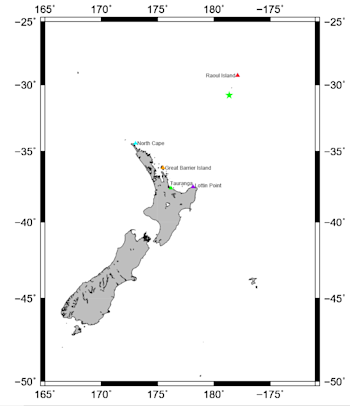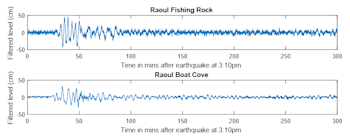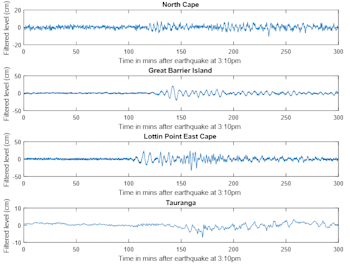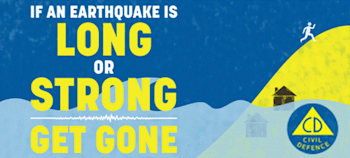
An unusual event affected the Kermadec region and northern New Zealand on Friday 8th December
The GeoNet tsunami gauge network recorded small tsunami waves shortly after seismic waves were generated in the Kermadec region – the cause of the seismic waves and the tsunami has been a bit mysterious but our scientists are on the case.
At 3.10pm local time on Friday 8th December (2.10am UTC) there was a magnitude 5.9 earthquake ~200km south of Raoul Island and on the southern margin of Curtis Island in the Kermadecs. Curtis Island is an uninhabited volcanic complex (made up of volcanic deposits) with a large geothermal component, which has experienced significant uplift in the past.
Over the 2-3 hours following the seismic waves a small tsunami was recorded at our Raoul Island pressure gauges (see the images below). The peak to trough amplitudes (highest to lowest points) recorded were up to 1 metre. Normally we would not expect to see tsunami waves caused by an earthquake of this magnitude; but the unusual tsunami activity triggered by this event was noted by one of our diligent scientists and passed on to the Duty Officer who was looking into the earlier seismic event.
A short time later, tsunami waves were also detected at various points around the North Island but at a much smaller scale. The locations of the pressure gauges are shown in the map above.
Our scientists at GNS and their colleagues within New Zealand and overseas set about unpicking the information. Since the event they have been able to collect more information and discuss the different possible processes (sometimes referred to as the source mechanism) that generated the seismic wave and related tsunami.
Based on their best attempts to model (build a picture of what occurred) and interpret the source mechanism the event is unlikely to have been the result of movement on a tectonic fault (i.e. a typical earthquake) or an underwater landslide. At this stage, there are three current ‘clubhouse leaders’- they are:
- A geothermal explosion (a steam and rock explosion underwater). This occurs when water is heated quickly, generating steam and as it expands it fractures the rocks.
- A large (several metres), sudden, upward movement on a circular fault (these are commonly found at volcanoes).
- It has also been discussed if the seismic waves were caused from an undetected submarine volcanic eruption- although for an eruption associated with an earthquake of this magnitude, we expect to have observed pumice floating on the surface or potentially SO2 gas emissions, and there are no known volcanic vents near the source of the seismic waves.
Interestingly, an almost identical event occurred in 2009 at roughly the same location, and there have been similar events observed offshore Japan in 1984, 1996, 2006 and 2015.
GNS and international scientist are working towards better understanding what occurred and we will continue to update you with what they will learn from this event.
If you’re heading to the beaches this summer- be sure you look at the local tsunami zone maps (here is the link to the MCDEM page – scroll down to find the region you’re going to). Remember- if you feel a long or strong earthquake, get gone.
Valuable scientific expertise has been received from Dr Jonathan Hanson, Dr William Power, Dr David Burbidge and Dr Caroline Holden Contacts: Dr Jonathan Hanson: j.hanson@gns.cri.nz







